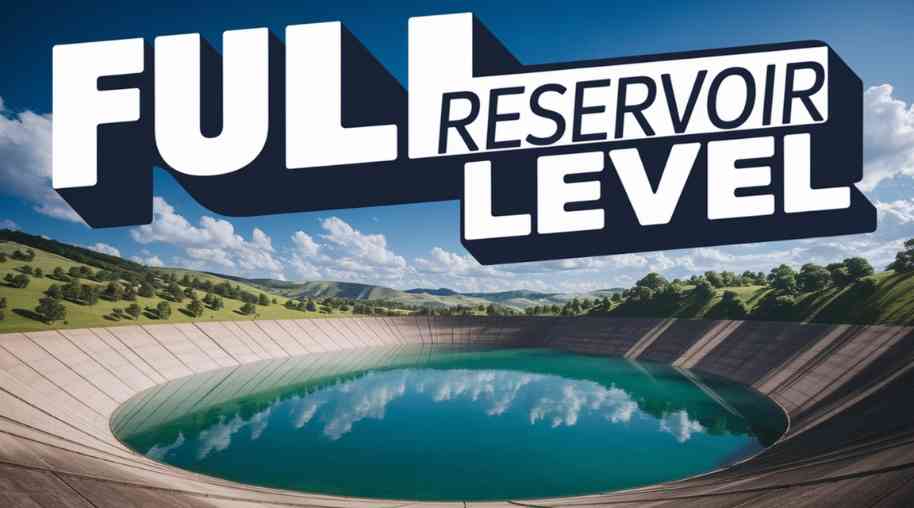FRL Full Form-Full Reservoir Level
by Shashi Gaherwar
0 3480
Introduction
Water reservoirs are vital for managing water resources, supporting needs like drinking water supply, irrigation, hydropower generation, and flood control. A critical component of reservoir management is maintaining the Full Reservoir Level (FRL), which defines the maximum safe water level a reservoir can hold. This article explores the concept of FRL, its significance, management strategies, and its impact across various sectors.

What is Full Reservoir Level (FRL)?
Full Reservoir Level (FRL) refers to the maximum permissible water level a reservoir can reach before excess water is released through spillways. This level is determined based on engineering assessments, environmental considerations, and safety regulations.
Key Aspects of FRL
- Maximum Safe Water Level: Prevents structural damage to the dam and ensures safety.
- Storage Capacity Indicator: Determines the reservoir’s ability to supply water for various needs.
- Flood Control Mechanism: Helps regulate excess water during heavy rainfall or monsoons.
- Operational Efficiency: Essential for effective hydropower generation and irrigation management.
Importance of Maintaining Full Reservoir Level
- Water Supply Security: Reservoirs at FRL ensure a stable water supply for domestic, industrial, and agricultural use, especially in drought-prone regions.
- Flood Control and Disaster Prevention: Managing FRL helps control excess water release, reducing the risk of downstream flooding and ensuring public safety.
- Hydropower Generation: Maintaining FRL is crucial for optimizing energy production in hydropower plants by ensuring consistent water flow.
- Irrigation and Agriculture: Reservoirs at full capacity provide reliable irrigation for farmlands, boosting agricultural productivity.
- Ecological Balance and Wildlife Support: Sufficient water levels maintain aquatic ecosystems, support biodiversity, and prevent habitat destruction.
Challenges in Managing Full Reservoir Level
- Climate Variability and Rainfall Patterns: Unpredictable rainfall and climate change can impact water inflows, complicating FRL management.
- Sedimentation and Storage Reduction: Over time, sediment deposits reduce reservoir storage capacity, affecting FRL maintenance.
- Dam Safety and Structural Risks: Maintaining water at FRL without proper monitoring can increase pressure on dam structures, leading to safety concerns.
- Conflicting Water Demands: Balancing water requirements for agriculture, industry, and power generation while maintaining FRL can be challenging.
Strategies for Effective FRL Management
- Real-Time Monitoring and Forecasting: Using advanced weather forecasting and reservoir monitoring systems helps predict inflows and manage water levels efficiently.
- Sediment Management and Dredging: Regular desilting and sediment removal ensure reservoirs maintain their designed capacity.
- Spillway Operations and Water Release Planning: Controlled release of excess water through spillways prevents overflows and minimizes flood risks.
- Integrated Water Resource Management (IWRM): A coordinated approach involving governments, communities, and industries helps optimize FRL management.
Full Reservoir Level vs. Dead Storage Level
- Full Reservoir Level (FRL): The maximum permissible water level in the reservoir, supporting water supply, hydropower, and flood control. It ensures optimal performance of the reservoir.
- Dead Storage Level (DSL): Represents the minimum storage level, usually retained for emergency use, such as severe drought conditions. It is critical for ensuring water availability during periods of extreme scarcity.
Case Studies of Successful FRL Management
- Bhakra Dam, India: Efficiently manages its FRL to supply irrigation water and generate hydropower while preventing floods.
- Three Gorges Dam, China: Employs advanced monitoring to regulate water levels and protect against floods.
- Hoover Dam, USA: Careful FRL management ensures water supply to multiple states while generating hydroelectric power.
Full Reservoir Level (FRL) plays a pivotal role in water resource management, ensuring sustainable water availability, flood control, and hydropower efficiency. Effective monitoring, climate adaptation strategies, and coordinated reservoir management are essential for maintaining safe and optimal FRL levels. Governments and water authorities must implement robust policies to balance water demands and environmental sustainability.
Further Learning Resources
If you’re passionate about building a successful blogging website, check out this helpful guide at Coding Tag – How to Start a Successful Blog. It offers practical steps and expert tips to kickstart your blogging journey!
For dedicated UPSC exam preparation, we highly recommend visiting www.iasmania.com. It offers well-structured resources, current affairs, and subject-wise notes tailored specifically for aspirants. Start your journey today!

Share:








Comments
Waiting for your comments